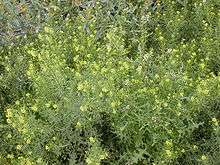Descurainia
| Descurainia | |
|---|---|
 | |
| Descurainia pinnata | |
| Scientific classification | |
| Kingdom: | Plantae |
| (unranked): | Angiosperms |
| (unranked): | Eudicots |
| (unranked): | Rosids |
| Order: | Brassicales |
| Family: | Brassicaceae |
| Genus: | Descurainia Webb & Berthel. |
| Species | |
|
40, See text | |
Descurainia is a genus of plants in the mustard family which are known commonly as the tansymustards.[1] They are similar in appearance to other mustards, sending up long erect stems and bearing small yellow or whitish flowers. Many species are noxious weeds. Some species are toxic to livestock and become a nuisance when they grow in grazing fields. Plants of this genus are found worldwide in temperate regions. Descurainia sophia, (flixweed or herb sophia), is the type species of Descurainia.
Selected species:
- Descurainia antarctica - Tierra del Fuego tansymustard
- Descurainia bourgaeana
- Descurainia californica - Sierra tansymustard
- Descurainia incana - mountain tansymustard
- Descurainia obtusa - blunt tansymustard
- Descurainia paradisa - paradise tansymustard
- Descurainia pinnata - western tansymustard
- Descurainia ramosissima - Villa Grove tansymustard
- Descurainia sophia - flixweed, herb-Sophia or tansy
- Descurainia sophioides - northern tansymustard
- Descurainia torulosa - Wind River tansymustard
References
- ↑ "Descurainia". Natural Resources Conservation Service PLANTS Database. USDA. Retrieved 17 January 2016.
External links
This article is issued from Wikipedia - version of the 1/18/2016. The text is available under the Creative Commons Attribution/Share Alike but additional terms may apply for the media files.